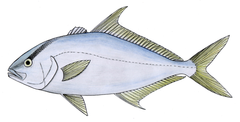Almaco jack
| Almaco jack | |
|---|---|
 | |
| Scientific classification | |
| Kingdom: | Animalia |
| Phylum: | Chordata |
| Class: | Actinopterygii |
| Order: | Perciformes |
| Family: | Carangidae |
| Genus: | Seriola |
| Species: | S. rivoliana |
| Binomial name | |
| Seriola rivoliana Valenciennes, 1833 | |
| Synonyms | |
| |
Almaco jack (Seriola rivoliana[1]) is a game fish of the family Carangidae; they are in the same family as yellowtail and amberjack.[2] They feed, both day and night, on other smaller fish such as baitfish and small squid. The flesh is thick and dense like tuna and can easily pass for white albacore if prepared as sushi.[2]
Taxonomy

Achille Valenciennes, and Georges Cuvier first described the Almaco jack. The description was published in 1833 although Cuvier died in 1832. Valenciennes and Cuvier together described many fish species, most notably in the 22 volume Histoire naturelle des poissons, (Natural History of Fish).[1]
Description
The Almaco jack has a less elongated, more flattened body than most jack species. Their dorsal fin and anal fins are elongated, and their outer edges have a definite sickle shape. The first rays of the Almaco dorsal fin's longest parts are nearly twice as long as the dorsal spines, also different from other jacks.
They reach a typical length of 90 centimetres (35 in), sometimes reaching 160 centimetres (63 in) and 59.9 kilograms (132 lb).[1]
Almaco jacks are generally dusky-colored with faint amber or olive stripes down their sides. Their upper bodies and lower fins are usually dark brown or dark blue-green. The belly is much lighter and appears brassy or lavender. The nuchal bar and most of the fins is dark on adults. Exceptions are the pelvic fins which are white on the ventral sides.
Distribution and habitat
The Almaco jack is a pelagic species that can be found in small groups on slopes and off of reefs at depths from 5 to 160 metres (2.7 to 87.5 fathoms). They visit wrecks more often than most other jacks. In the Indian to the west Pacific oceans, Almaco jack live from Kenya to South Africa and have been spotted off Mariana Islands, Wake island, Ryukyu Islands, Kermadec Islands and New Caledonia. In the eastern Pacific, Almaco jack live from California to Peru and the Galapagos islands. In the western Atlantic, they live mostly from Cape Cod to northern Argentina although they are rare off North and South Carolina. Almaco jack are not as common in the Eastern Atlantic as elsewhere. Almaco live near Great Britain and off Lampedusa in the Mediterranean sea.[citation needed] They typically swim at depths ranging from 5–35 metres (16–115 ft).[1]
Behavior
Almaco jack's unusual stamina makes them a prime target for deep sea fishermen.
They remove skin-based parasites by rubbing against the rough skin of passing sharks. Almaco jack also rub against passing scuba divers because they mistake them for sharks.[3]
Breeding
These fish spawn as often as weekly throughout the year.[4]
Aquaculture
Almaco jacks are farmed/ranched near the Island of Hawaii under the brand name Kona Kampachi as a domesticated alternative to wild tuna. Global production reached 1,000,000 pounds (450,000 kg) in 2008.[2][5] Almaco jack can cause a disease in humans called ciguatera through bioaccumulation of ciguatoxin produced by a microscopic organism called dinoflagellate.[2] They have never been commercially harvested on a large scale and are abundant in the wild.[2] Farmed Almacos on a controlled diet are free of dinoflagellates.[2]
These fish have among the best feed-conversion ratios ever achieved. With no selective breeding at all, the amount of fish required to produce one pound ranges from 1.6:1-2:1, ten times better than the observed ratio for bluefin tuna. The resulting meat has a fat content of around 30%.[4]
They grow in diamond-shaped net pens moored to the sea bottom 800 feet (240 m) below. The area experiences strong currents that mitigates the impact of the waste that the fish drop.[4]
Notes
- ↑ 1.0 1.1 1.2 1.3 Froese, Rainer and Pauly, Daniel, eds. (2006). "Seriola rivoliana" in FishBase. April 2006 version.
- ↑ 2.0 2.1 2.2 2.3 2.4 2.5 Greenberg 2010
- ↑ Seriola rivoliana, Almaco Jack - MarineBio.org. Retrieved Monday, January 21, 2008, from http://marinebio.org/species.asp?id=442
- ↑ 4.0 4.1 4.2 Greenberg 2010, 3171
- ↑ "Kona Blue". Kona Blue Water Farms. Retrieved 2008-06-25.
References
- Seriola rivoliana, Almaco Jack - MarineBio.org. Retrieved Monday, January 21, 2008..
- IUCN 2007. 2007 IUCN Red List of Threatened Species. Downloaded on 21 January 2008.
- Greenberg, Paul (July 2010). Four Fish: The Future of the Last Wild Food. The Penguin Press. ISBN 978-1-59420-256-8.